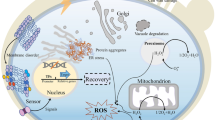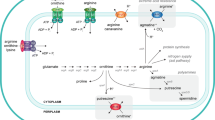Abstract
Among examined microbial growth regulators of alkyl hydroxybenzene group (hexylresorcinol, methylresorcinol, and hydroxyethylphenol), only hexylresorcinol induces cellular SOS response, demonstrating a dose-dependent increase of the induction factor in the SOS chromotest with the Escherichia coli PQ37 strain. At the highest of used concentrations (100 μg/ml), hydroxyethylphenol and nonalkylated resorcinol were shown to exert a weak toxic effect, reducing the activity of constitutive alkaline phosphatase, but did not induce SOS response. Nontoxic methylresorcinol did not induce genome damage, which can trigger SOS functions. It is concluded that substitutions in phenolic ring affect genotoxic activity of alkylresorcinols.
Similar content being viewed by others
References
Golovlev, E.L., Phenotypic Metastability of Bacteria, Mikrobiologiya, 1998, vol. 59, no. 2, pp. 149-155.
Mil'ko, E.S. and Egorov, N.S., Geterogennost' populyatsii bakterii i protsess dissotsiatsii (Heterogeneity of the Bacterial Population and the Dissociation Process), Moscow: Mosk. Gos. Univ., 1991, p. 143.
Doroshenko, E.V., Loiko, N.G., Il'inskaya, O.N., et al., Characterization of Bacillus cereus Dissociants, Mikrobiologiya, 2001, vol. 70, no. 6, pp. 811-819.
Osipov, G.A., El'-Registan, G.I., Svetlichnyi, V.A., et al., On the Chemical Nature of Autoregulatory Factor d of Pseudomonas carboxydoflava, Mikrobiologiya, 1985, vol. 54, no. 2, pp. 186-190.
Batrakov, S.G., El'-Registan, G.I., Pridachina, N.N., et al., Tirosol, Autoregulatory Factor d1 of Saccharomyces cerevisiae, Mikrobiologiya, 1993, vol. 62, no. 4, pp. 633-638.
Svetlichnyi, V.A., El'-Registan, G.I., and Romanova, A.K., A Study of the Content of Membrane-Active Autoregulators in Litotrophically Growing Pseudomonas carboxydoflava, Mikrobiologiya, 1986, vol. 55, no. 1, pp. 55-59.
Mulyukin, A.L., Kozlova, A.N., Kaprel'yants, A.S., and El'-Registan, G.I., Detection and Study of the Accumulation Dynamics of Autoregulatory Factor d1 in the Culture Medium and Micrococcus luteus Cells, Mikrobiologiya, 1996, vol. 65, no. 1, pp. 20-25.
Il'inskaya, O.N., Kolpakov, A.I., Zelenikhin, P.V., et al., The Effect of Bacterial Anabiosis Inducers on the Bacterial Cell Genome, Mikrobiologiya, 2002, vol. 71, no. 2, pp. 164-168.
Quillardet, P. and Hofnung, M., The Screening, Diagnosis and Evaluation of Genotoxic Agents with Batteries of Bacterial Tests, Mutat. Res., 1988, vol. 205, pp. 107-118.
Vasilieva, S., SOS-Chromotest Methodology for Fundamental Genetic Research, Res. Microbiol., 2002, vol. 153, no. 7, pp. 435-440.
Vasilieva, S., Tanirbergenov, T., Abilev, S., et al., A Comparative Study of Mutagenic and SOS-Inducing Activity of Biphenils, Phenanthrenequinones and Fluorenes, Mutat. Res., 1990, vol. 244, pp. 321-329.
Von der Hude, W., Seelbach, A., and Basler, A., Epoxides: Comparison of the Induction of SOS Repair in Escherichia coli and Bacterial Mutagenicity in the Ames Test, Mutat. Res., 1990, vol. 231, pp. 205-218.
Mulyukin, A.L., Generation of Quiescent Forms in Non-Sporogenic Microorganisms, Cand. Sci. Dissertation, Moscow, 1998.
Batrakov, S.G., El'-Registan, G.I., Pridachina, N.N., et al., Tirosol, Autoregulatory Factor d1 of Saccharomyces cerevisiae, Mikrobiologiya, 1993, vol. 62, no. 4, pp. 633-638.
Il'inskaya, O.N., Ivanchenko, O.B., and Karamova, N.S., Opredelenie genotoksichnosti veshchestv v kratkosrochnykh test-sistemakh. Metodicheskoe rukovodstvo (Genotoxicity Estimation in Short-Term Test Systems: A Methodical Recommendations), Kaliningrad: Kaliningrad. Gos. Univ., 1995.
Eder, E. and Deininger, C., The Influence of the Solvents DMSO and Ethanol on the Genotoxicity of ?,?-Unsaturated Aldehydes in the SOS-Chromotest, Mutat. Res., 2002, vol. 516, nos. 1-2, pp. 81-89.
Miller, J., Experiments in Molecular Genetics, Cold Spring Harbor, New York: Cold Springs Harbor Lab., 1976, pp. 324-327.
Quillardet, P., Huisman, O., D Ari, R., and Hofnung, M., SOS-Chromotest, a Direct Assay of a SOS-Function in Escherichia coli K-12 to Measure Genotoxicity, Proc. Natl. Acad. Sci. USA, 1982, vol. 79, pp. 5971-5975.
Mersch-Sundermann, V., Kern, S., and Wintermann, F., Genotoxicity of Nitrated Polycyclic Aromatic Hydrocarbons and Related Structures on E. coli PQ37 (SOSChromotest), Environ. Mol. Mutagen., 1992, vol. 18, pp. 41-50.
Prozorov, A.A., Recombinant Rearrangements of the Bacterial Genome and Adaptation to the Environment, Mikrobiologiya, 2001, vol. 70, no. 5, pp. 581-594.
Hladyszowski, J., Zubic, L., and Kozubek, A., Quantum Mechanical and Experimental Oxidation Studies of Pentadecylresorcinol, Olivetol, Orcinol and Resorcinol, Free Radic. Res., 1998, vol. 28, no. 4, pp. 359-368.
Author information
Authors and Affiliations
Rights and permissions
About this article
Cite this article
Margulis, A.B., Il'inskaya, O.N., Kolpakov, A.I. et al. Induction of SOS Response by Autoregulatory Factors of Microorganisms. Russian Journal of Genetics 39, 993–996 (2003). https://doi.org/10.1023/A:1025714815704
Issue Date:
DOI: https://doi.org/10.1023/A:1025714815704




